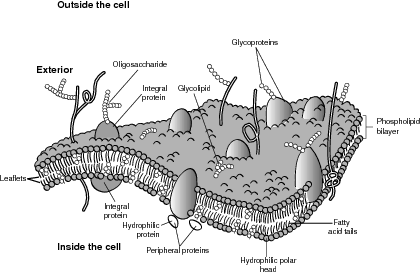Cells have the tendency to separate a high energy outside from a lower energy inside. This is done by the difference in electrical charges associated with certain ions and differences in the concentration of certain molecules.
A good example of these difference would be the hydrogen ion. They are usually found in greater amounts on the outside of the cell. Therefore, there is a greater positive charge outside than inside. This difference in charges and concentration will cause the hydrogen ions to push themselves into the cell. Now, this process is very important because it does generate ATP, once it passes by a "turbine" within the membrane, generating a useful work.The sum of the concentration push and electrical push is known to be electrochemical gradient.
The cellular membrane is formed primarily by phospholipids, these make the main structure of this membrane in what is called bilayer. These phospholipids are divided into two parts: The head group which is hydrophilic, formed by several oxygen atoms and one or more nitrogen atoms (polar bonds). The head group likes to interact with water via dipole-dipole interactions, hydrogen bonds, and even ion-dipole interactions. This allows the build up of sterols, which will provide the membrane rigidity and integrity during temperature changes.

The second part of the phospholipids stay in the centre of the membrane. They do not contain any oxygen nor nitrogen atoms, thus, they are hydrophobic, and will have hydrophobic interactions with each other. There are two type in the hydrophobic portion: (1)saturated and (2)unsaturated portions.
- Saturated layer are packed more tightly and make the membrane less fluid
- Unsaturated layer are less packed and make the membrane less packed, making it more fluid.
This hydrophobic portion of the membrane will keep H ions out or in, creating a electrochemical gradient. That is why there will be proteins built into the membrane. These proteins will not only work as gates for this chemical to pass through the membrane, but they will also play a very important role in production of energy and sensory information.
Membranes keep a constant state of flux, so homoeostasis can be constantly achieved regardless of change in environment.
Summary: The basic structure a cellular membrane is demonstrated by the the Fluid Mosaic Model, which consists of a lipid bilayer which has a hydrophobic centre and hydrophilic surfaces. proteins may be attached to the surface of the lipid bilayer or inserted into or across it. Besides providing physical separation cellular membranes are very important for energy processes in the cell. If the concentration gradient is formed which stores free energy. If the number of cation or anions on one side of the membrane is greater than the number of counter-ions, then an electrical gradient is also formed which stores free energy. Often the two together to form an electrochemical gradient.
Nenhum comentário:
Postar um comentário